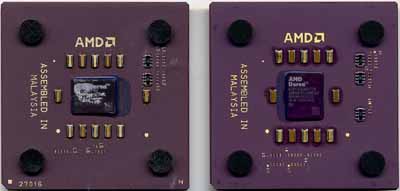The Chip
The Morgan core is to the Duron, what the Palomino core was to the Athlon. In fact, you can think of the Morgan core to be the Palomino core with a 64KB L2 instead of a 256KB L2.
Out with the old and in with the new - Spitfire core to the left, Morgan to the right
The major enhancements boasted by the Morgan and Palomino cores are described in detail here in our Athlon 4 Technology Review. Some of the key enhancements are:
- Data Prefetch
- SSE Support
- Improved L1 TLBs
- On-die Thermal Diode
Once again, you can read up on those enhancements and more here.
The 1GHz Duron is of course based on the Morgan core, while previous Durons were based on the Thunderbird derived Spitfire core. All of the critical stats are listed in the below table:
|
CPU
Specification Comparison
|
|||||||
|
AMD
Duron
|
AMD
Duron
|
AMD
Athlon
|
Intel
Pentium 4
|
Intel
Pentium III
|
Celeron
|
||
|
Core
|
Spitfire
|
Morgan
|
Thunderbird
|
Willamette
|
Coppermine
|
Coppermine
128
|
|
|
Clock
Speed
|
600
- 900MHz
|
1GHz+
|
750
- 1400MHz
|
1.3GHz
- 1.5GHz
|
500
- 1000MHz
|
533
- 850MHz
|
|
|
L1
Cache
|
128KB
|
8KB
Data
|
32KB
|
||||
|
L2
Cache
|
64KB
|
256KB
|
256KB
|
256KB
|
128KB
|
||
|
L2
Cache speed
|
Core
Clock
|
||||||
|
L2
Cache bus
|
64-bit
|
256-bit
|
|||||
|
System
Bus
|
100MHz
DDR EV6
|
100/133MHz
DDR EV6
|
100MHz
quad-pumped GTL+
|
100/133MHz
GTL+
|
|||
|
Interface
|
Socket-462
(Socket-A)
|
Socket-423
|
Slot-1/Socket-370
|
Socket-370
|
|||
|
Manufacturing
Process |
0.18-micron
|
||||||
|
Die
Size
|
100mm^2
|
106mm^2
|
120mm^2
|
217mm^2
|
106mm^2
|
106mm^2
|
|
|
Transistor
Count
|
25
million
|
25.18
million
|
37
million
|
42
million
|
28
million
|
28
million
|
|
The chip needs primarily BIOS support in order to work properly. As we mentioned earlier, the ECS K7S5A board we used in the review has Morgan support in its latest BIOS.
In terms of overclocking potential, the K7S5A limited our overclocking experimentation without having any adjustable multiplier or voltage support. At 10 x 133MHz (1.33GHz) the Duron would POST but immediately reboot before even attempting to boot to the OS. With some better cooling and a higher core voltage than its 1.75V default we’d expect the Duron to be able to hit 1.13 – 1.2GHz without too much effort.











0 Comments
View All Comments